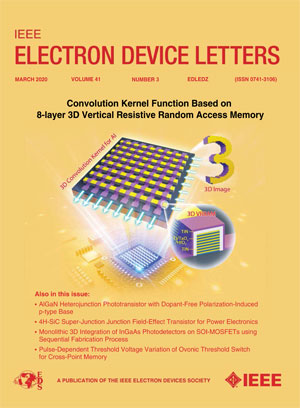利用沉积后退火技术在带有 IGZO 沟道的 Hf0.5Zr0.5O2 FeFET 中演示大 MW 和出色的耐用性
IF 4.1
2区 工程技术
Q2 ENGINEERING, ELECTRICAL & ELECTRONIC
引用次数: 0
摘要
近年来,具有非晶氧化物半导体(AOS)沟道的基于 HfO2 的 FeFET 在后端集成(BEOL)方面展现出了巨大的潜力,其应用前景令人瞩目,但其耐久性有限的问题仍未得到解决,这主要是由于 AOS 的热稳定性较差以及制造工艺受到影响。在这项工作中,我们提出了一种沉积后退火(PDA)工艺来结晶 Hf $_{{0}.{5}}$ Zr $_{{0}.{5}}$ O2(HZO)层。与通过传统的金属后退火(PMA)方法获得的场效应晶体管相比,由于 HZO-AOS 界面更好,优化后的场效应晶体管的耐久性显著提高。通过 TCAD 仿真,我们证明了 HZO 层的介电常数越低,可实现的存储窗口(MW)就越大,而残余极化效应的减小则相对较小。所提出的 FeFET 显示出优越的大 MW(3 V)和出色的耐用性,实现了 10^{{10}}$ 周期,仅有轻微的 MW 衰减,并具有 2 位/单元的数据存储能力。本文章由计算机程序翻译,如有差异,请以英文原文为准。
Demonstration of Large MW and Prominent Endurance in a Hf0.5Zr0.5O2 FeFET With IGZO Channel Utilizing Postdeposition Annealing
With high potential for back-end-of-line (BEOL) integration, HfO2-based FeFETs with amorphous oxide semiconductor (AOS) channels have shown impressive application prospects in recent years, but the issue of limited endurance is still unsolved, which can be mainly attributed to the poor thermal stability of AOSs and the compromised manufacturing process. In this work, we propose a postdeposition annealing (PDA) process to crystallize the Hf
$_{{0}.{5}}$
Zr
$_{{0}.{5}}$
O2 (HZO) layer. Compared with that of the FeFET obtained via the conventional post-metal annealing (PMA) method, the endurance of the optimized FeFET is significantly improved owing to the better HZO-AOS interface. With a TCAD simulation, we prove that the lower the dielectric constant of the HZO layer is, the greater the memory window (MW) that can be achieved, whereas the decreased remnant polarization effect is relatively slight. The proposed FeFET shows a superior large MW (3 V) and excellent endurance, achieving
$10^{{10}}$
cycles with only slight MW degradation, and a 2-bit/cell data storage ability.
求助全文
通过发布文献求助,成功后即可免费获取论文全文。
去求助
来源期刊

IEEE Electron Device Letters
工程技术-工程:电子与电气
CiteScore
8.20
自引率
10.20%
发文量
551
审稿时长
1.4 months
期刊介绍:
IEEE Electron Device Letters publishes original and significant contributions relating to the theory, modeling, design, performance and reliability of electron and ion integrated circuit devices and interconnects, involving insulators, metals, organic materials, micro-plasmas, semiconductors, quantum-effect structures, vacuum devices, and emerging materials with applications in bioelectronics, biomedical electronics, computation, communications, displays, microelectromechanics, imaging, micro-actuators, nanoelectronics, optoelectronics, photovoltaics, power ICs and micro-sensors.
 求助内容:
求助内容: 应助结果提醒方式:
应助结果提醒方式:


